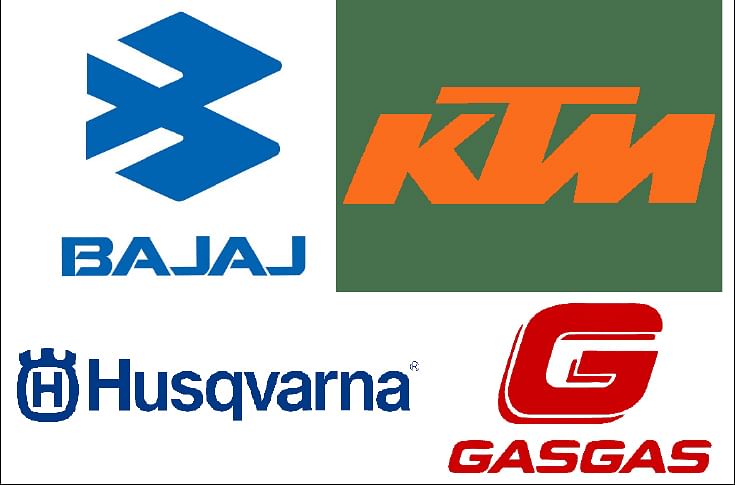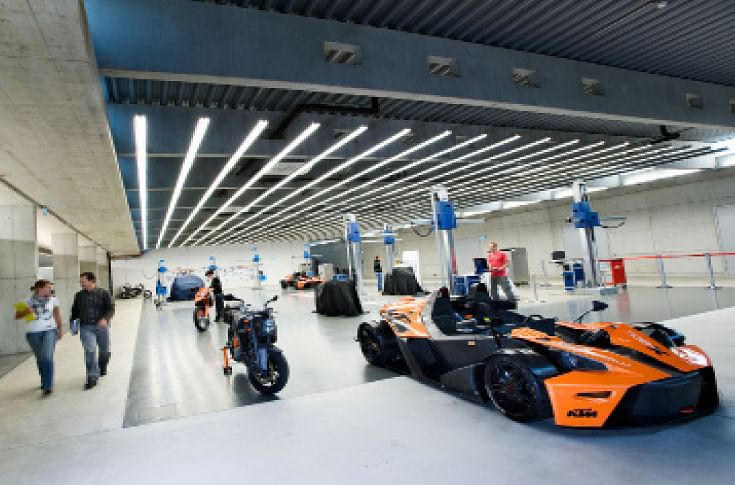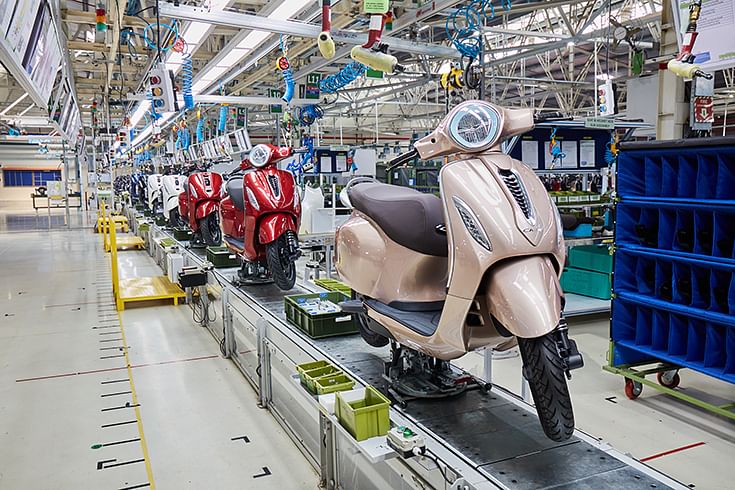Rajiv Bajaj: ‘We are now a complete motorcycle manufacturer.’
Rajiv Bajaj, Managing Director of Bajaj Auto, believes that the recent move to deepen the alliance with Pierer Mobility will pave the way for a host of opportunities in mobility.
It was in 2007 when Bajaj Auto first took a 14 percent stake in KTM, sowing the seeds for a successful partnership which has grown from strength to strength since then.
This has now moved to the next level with an equity swap deal which will see the Indian two-wheeler maker play a more proactive role with its Austrian ally’s parent company, Pierer Mobility. “Basically so far we were participating only in the motorcycle business which was about KTM and Husqvarna,” explains Rajiv Bajaj, Managing Director, Bajaj Auto.
To that extent, it has been a very holistic partnership in the sense that “we are doing the design, development, infotainment, manufacturing and all those activities for bikes below 400cc”. Additionally, the responsibilities include carrying out marketing, sales and managing the brands in many markets including India.
“I would say that this is a large enough canvas but now it has moved on to the GasGas brand and the e-bike business which is really going to play a very, very big role,” continues Bajaj. Right now, it (e-bikes) may be more of a European phenomenon because “all said and done”, good quality electric vehicles are not affordable for "our adaption…but it will happen over time”.
Anti-car strategy
The MD believes all this has tremendous implications moving forward, especially with the kind of change now underway in some European cities where “you can see the whole structure of what we call micro mobility or intra- city mobility or urban mobility”. It is this core that is going to see a rapid transition in the coming years.

“I have always said that our position as a company, as distinct from the individual position of a product, which makes motorcycles, three-wheelers and now scooters like Chetak is that we are an anti-car company. It does not mean that we are personally anti-cars but as a company our strategy is anti-car. And the world is moving in that direction,” says Bajaj.
After all, a host of cities have already declared their intention to be car-free. As he adds, somebody may do this in a 20km radius, or a 50km radius but it “just tells us that cars frankly have no future” in the cities where a large percentage of the population resides.
Hence, it is crystal clear that city transportation becomes very important in the process and the key question is what would then be appropriate which is also sustainable. “I think it comes down to two things: one is, of course, there has to be excellent public transport whether you get buses, metros or trams. It is also inevitable that there needs to be individual personal mobility as well,” explains Bajaj.
In this backdrop, there is no doubt that electric will play the biggest role and there is “also no doubt” that electric becomes more and more feasible and viable when “you talk of lighter vehicles” like two- and three-wheelers. “For me, apart from public transport, personal mobility of the future is about (pedestrian) walking, cycling, e-bikes in the form of light scooters, light motorcycles and light three-wheelers,” says Bajaj.
This is what “we will see in our roads in the future” where it will be amply evident that they will not only be sustainable but also green and will free up a lot of space in the process. Today in the big cities of the world, the footprint of just the parking lot of a car takes up 15-30 percent of the land area of a city. All this huge space will be released not only in parking lots but on the actual road itself.
“Today, the problem is that with so many of these cars, vans, buses and trucks — when I say anti-car, I am including all of these which are highly inefficient and polluting —. . . those of us who are pedestrians, cyclists or riders of two-wheelers/passenger three-wheelers are vulnerable because these fellows are always running over us,” says Bajaj.
On the other hand, if there are no cars, vans and buses in the future, “we will not be anxious if our kids are out there” cycling or on e-bikes, scooters or motorcycles. This is because by and large there will be a problem only if “we make a mistake and not because the guy behind you runs over you”.
Bajaj believes this will not only be sustainable but a lot safer and more affordable. Sure, cars will be there outside the cities but more for intercity transport as part of an ideal situation. This, according to him, is “very, very important” especially when Stefan Pierer, the CEO of Pierer Mobility (the parent company which owns KTM, Husqvarna, GasGas and R Raymon) and a partner of 15 years, has done a “great job of bikes” and can follow in their wake and bring suitable products to India in the future.
Getting future design-ready with Kiska

As a result of this expansion of the alliance, Bajaj Auto will also participate/partner with Kiska in Salzburg, Vienna, which does all the design work. “You can say that we are now a complete motorcycle manufacturer because we cover everything,” says its MD.
This means not only the motorcycle but also “the allied things” like three-wheelers, e-bikes, design — “we of course have our own design here and recently our design studios are up and running both in Barcelona, Spain and Bangkok, Thailand”. With Kiska also getting into this domain, the entire picture becomes complete in terms of all the skills, segments and technologies which “make us very, very complete”.
Rather than be termed a mobility solutions provider which has become a fashionable term in recent terms, Bajaj would rather keep things simple and reiterate that “we are a motorcycle company”. He points out the case of McDonald’s where the burger is the core of its business. It does not mean that McDonald’s only makes burgers but this remains the centre and the brand derives its primary strength and position in the marketplace basis that.
“By the same measure, I am saying that by far the biggest part of our business either domestically or globally is the motorcycle…all kinds of motorcycles and it will always be like that at least in the foreseeable future,” says Bajaj. To that e-bikes will get added, Chetak has just got added while three-wheelers are already there. Motorcycles are over 50 percent of “what we do” and remain the centre of “who we are” — perhaps “not all of but primarily what we are”.
KTM has also been in the news for the recently created swappable batteries motorcycle consortium which includes Honda, Yamaha and Piaggio. Once again, this is a statement of intent in the electric space even while the fact remains that the whole EV world is just at a nascent stage right now.
“What partnerships, technologies, brands, products and batteries will work in the future nobody knows. So, it is very hard to say that partnerships made today are going to go in which direction, what will be the outcome after some years,” says Bajaj. To that extent, all this is at an early stage but the fact that companies are coming together “can only be a positive”.
Electric avenue

It is also very likely that Bajaj Auto’s Akurdi plant in Pune will be the base for its electric foray though nothing has been decided yet. For now, it remains a potential site and the task on hand is to evaluate the pros and cons before taking a final call.
Whilst on the subject of electric and its roadmap in India, the MD’s first reaction is that different people are saying different things…NITI Aayog has one narrative which is not necessarily exactly the same as that of the Ministry of Road Transport & Highways. ”If you talk to incumbent players, they will say one thing and if you talk to start-ups they will say another thing,” he adds.
By the end of the day, this then boils down to being a reflection of hopes, ambitions, opinions and fears expressed by various people and organisations rather than the actual truth. The only thing “that makes sense” is that it is not the manufacturer but finally the customer who shapes the market.
“Today if you ask me if I see any signs that the consumer is lining up en masse for adoption of EVs, I don't see them. But do I see signs that people more than before now — for whatever reason be it the environment, petrol prices, availability of better products — are interested, I would say that definitely there is greater interest and enthusiasm,” concedes Bajaj.
Sure, people are buying more EVs but the fact remains that it is still a very minuscule number of one percent and not 10 percent, let alone anywhere near 80 percent which policymakers and politicians are proclaiming as the goal for 2030.
“I am not going to say that 80 percent can or can’t happen by 2030…all I am going to say is that as a sensible and progressive organisation, we are going to be prepared,” he adds. Now, if only 10-20 percent migrate to electric, it is only logical that “we would like” to still have a very strong position in internal combustion engines.
On the other hand, if 80 percent do move to electric, “we will do our best” to be part of that 80 percent. As Bajaj reiterates, companies cannot change their strategies based on what some individuals say — after all ministers and bureaucrats come and go — but will instead plan for the future based on the customer who is not going anywhere and is here to stay.
For now, electric offerings from two-wheeler makers enjoy a host of subsidies ranging from concessional GST of five percent (compared to 28 percent for petrol versions) to those offered by FAME 2 and by various states which are now part of the EV juggernaut. All these sops add to nearly Rs 100,000 per vehicle.
Can all this continue forever? If one million vehicles convert to electric and if this level of subsidy is still applicable in the future, it works out to a whopping Rs 10,000 crore. For five million vehicles, or 25 percent of the two-wheeler population, this increases to Rs 50,000 crore. “Do I believe that the government or any government of the world has the strength to keep doling out Rs 50,000 crore to Rs 150,000 crore to just one subsection of industry? Not a chance!” exclaims Bajaj.
On the other hand, if the industry is given an assurance that all these subsidies will continue for the next decade, it then makes sense for companies to plan accordingly. He is also irked by casual statements that Indian industry is averse to taking risks.
“My point is risk is taken in what? Risk is not taken in short-term decisions. We are talking about the risk of long-term strategy and long-term technology. When you want us to take risks, why don’t you give us at least visibility for a 10-year runway?” he counters.
More specifically, it is important to assure companies that these subsidies will continue for the next 10 years instead of yanking them off abruptly in three years leaving manufacturers, suppliers and dealers high and dry. “What happens then? The consumer will stop buying my Chetak. If I am selling it at Rs 150,000 today thanks to subsidies and if you remove them tomorrow, I will have to charge Rs 250,000. Do you think the same volumes will continue?” asks Bajaj.
The bottomline is that at the end, the power lies with the consumer and depending on how “you give him a carrot” he will react accordingly. Tomorrow if the subsidy is doubled to Rs 200,000, “I can guarantee you the whole industry will shift to electric”. However, if it becomes zero on the other hand from Rs 100,000, then “will we still be talking of 10 million scooters a year? I want to see that happen”.
This is where CEOs need to outline their priorities clearly. “My view has always been that if as a CEO you pay attention to what people are saying on the outside it is your problem. I listen to everything of course — after all I don't believe I exist in isolation and am part of an ecosystem — but that doesn't mean I have to react,” says Bajaj.
On the contrary, the key is to respond appropriately . . . and to what does not make business sense, “my first reaction is that you have to go by unshakeable facts and the magic of logic”. Simply put, there is no point pursuing an idea when it is not viable. “If some CEO decides to go with the wind, it is his problem . . . he is consciously making that choice,” adds Bajaj.
As he puts it, each business leader has to decide what the signal is and plan accordingly. “For me, it is very clear that as of now, I see greater interest in EVs on behalf of the consumer. I do not see any signs to show that there is going to be the kind of mass adoption that people are talking about but that is my call. If somebody feels differently, he is free to follow his judgement call,” he adds.
Bajaj also does not think the issue of finding the right skills in electric is something to lose sleep over since this is inevitable with anything new. Skills were scarce during the transition time of the four-stroke engine and fuel injection but the show went on.
“This is nothing but comes with the territory and characteristic of competing in the open market. If people are uncomfortable with this, it just means that if the kitchen is too hot for you — get out of the kitchen,” declares Bajaj.
This feature was first published in Autocar Professional's November 1 issue.
RELATED ARTICLES
Belrise Industries: A Story of Grit and Focus
The Belrise Industries IPO is the culmination of a multi-decade journey by entrepreneur Shrikant Badve that started in a...
Mahindra and Lightweighting: Solid Steel To Nimble Aluminum
Stricter emission regulations and rising fuel efficiency targets are driving a fundamental transformation in powertrain ...
Hero vs Honda: In Numbers
A Comparative Study of Honda Motorcycle & Scooter India and Hero MotoCorp.





 03 Nov 2021
03 Nov 2021
 81323 Views
81323 Views





 Shahkar Abidi
Shahkar Abidi


 Ketan Thakkar
Ketan Thakkar

 Autocar Professional Bureau
Autocar Professional Bureau

